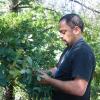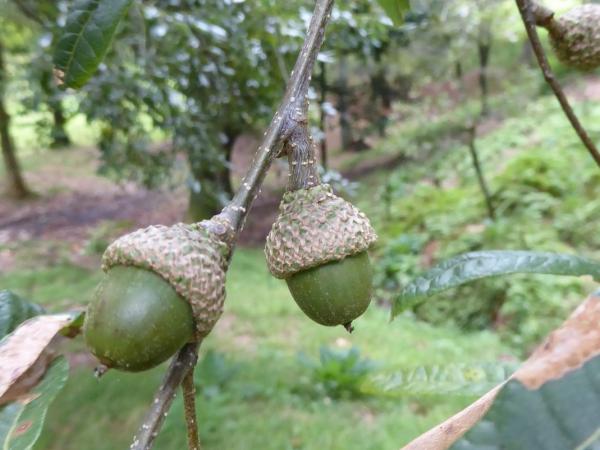Editor's Picks
Plant Focus
Back from the Brink: Quercus tardifolia
“I still remember the tone in Michael Eason’s voice coming over the radio last May: ’Hey Adam, get over here.’ In a remote canyon in the Chisos Mountains in Big Bend National Park, eight of us had just spread out in four teams of two to systematically search a gentle slope in a manner similar to looking for a human corpse, but hopeful we would find a living oak that some had deemed extinct. Elizabeth Thomas and I were taking up the western flank of the array and we had barely arrived at our starting point when the summons crackled over the radio, lacking excitement but with serious certainty conveying that something good surely had been found.”
This is how Adam Black recalled the moment he first heard that a single tree of Quercus tardifolia, a species once thought to be extinct, had been discovered in Big Bend National Park in Texas. A group of botanical researchers led by The Morton Arboretum and United States Botanic Garden (for the most part members of the IOS), found the lone oak on May 25, 2022. First described in the 1930s, the last living specimen was believed to have perished in 2011.

As Adam tells it: “Retracing our steps, startling a thin black bear as we rounded a bend in the trail, we soon heard scrutinizing voices laced with excitement. My default, discouraging answer (‘It’s just another odd Quercus gravesii’) was loaded on my tongue and ready to fly. But as I approached the tree, I could see from afar that it was different, well before I could even focus on the leaves. And I could tell from the excitement creeping out from poker faces of those surrounding the tree that this was clearly something. Michael, who found the tree, handed me a leaf, and as soon as I saw it, I swallowed my prepared answer, and I think I just nodded as I silently confirmed all the diagnostic features of Quercus tardifolia were present—while staring at a ghost.”

The oak is in a dire state. The trunk is scarred by fire and shows signs of severe fungal infection. A drought or fire has the potential to end its life, say the scientists who found it. And they report that climate change makes this outcome more likely every year. The group is now working with the National Park Service to reduce the immediate wildfire threat to the tree, and conservationists in this collaborative are moving quickly to return to search for acorns and to attempt propagation.

“This is important, collaborative research necessary for the conservation of Q. tardifolia,” said Carolyn Whiting, a botanist at Big Bend National Park. “The Chisos Mountains support a high diversity of oak species, partly because of the wide range of habitats available in this ‘sky island.’ There is still much to learn about the oaks in the Chisos.”
“The United States Botanic Garden is thrilled about the success of this partnership and collecting trip that rediscovered such a rare oak,” said Susan Pell, acting executive director at the United States Botanic Garden, which is funding and collaborating on the project. “This discovery is just the beginning of the conservation work we are doing in partnership with The Morton Arboretum to better understand and conserve threatened trees.”
Molecular analysis will confirm whether the DNA of the newly discovered tree matches that of previous samples of Q. tardifolia, but according to the researchers, there is a chance that the analysis will raise more questions than answers. Andrew Hipp, IOS member and senior scientist in plant systematics and herbarium director at The Morton Arboretum, will lead the team conducting the genetic analysis. “This is an interesting problem,” he said. “We’re looking into whether this tree is genetically similar to other trees that have been previously collected as Q. tardifolia. That should tell us whether this collection is the same as what Cornelius H. Muller named Q. tardifolia. It should also tell us whether this collection of specimens is genetically distinct enough from other closely related oaks in the area to warrant recognition as a species.”

Regardless of classification, Andrew noted that it is important to preserve more than individual species, but rather all the genetic variation in life. “Species are genetically distinct populations that we can generally recognize in the field,” he said. “But they aren’t the be-all and end-all of conservation. We also aim to protect the functional variation within species. Leaf forms, physiological responses to drought and fire and even tree longevity are all attributes that can be shared among populations and among species by gene flow. The functional variation that these new collections represent may be just what is needed to help oaks of the region adapt to environmental changes in the near or distant future.”
Oaks are exceptional among tree species in that their acorns cannot be traditionally seed-banked for conservation purposes. According to the researchers, they must be preserved in the wild or in living collections, which is why the involvement of botanical gardens is critical. The researchers who found the Q. tardifolia tree are concerned that it is not producing acorns. Other methods of propagation, including grafting, are being pursued to preserve the oak’s future.

“In many ways, this tree is an ancient relic. Due to the changing climate, the world is completely different now than when it evolved,” said Wesley Knapp, chief botanist at NatureServe, who participated in the expedition. “It is incumbent upon us to learn from it and protect it while we still can in order to inform future conservation efforts,” he said. “Nature rarely hands us a second chance, and I doubt we’ll get a third. We won’t waste it.”
The rediscovery of Q. tardifolia represents a huge achievement. Michael Eason credits Adam for his persistence in spearheading conservation efforts focused on the oaks of West Texas. “I had heard of Adam back in 2017, he had been coming out to West Texas to collect and examine oaks for the IOS, and later had been working with the Global Conservation Consortium for Oak, which he invited me to join a year ago. During this time he persistently pushed for more research into the oaks of West Texas, saying ‘We need to know what we are conserving here: one species or four, are these hybrids or distinct species?’”

Michael also emphasizes the importance of the group’s experience in bringing about the success of the venture. “The decades of combined field experience and plant knowledge, local knowledge of the area, years of studying oaks and other flora . . . all of it was key,“ he said. “It takes a special skill to recognize morphological differences in growth, leaf shape, the way the leaves hang, slight variances in the green color spectrum, bark patterns, etc. That ability to take it all in, briefly, and consume the gestalt, and to say: this is something different. Not too many folks have it, so kudos to Adam for pulling together a crackerjack team.”
The Morton Arboretum not only spearheaded the project and helped secure the required funding, but also provided the assistance of Amy Byrne, Global Tree Conservation Coordinator for GCCO, to manage the enterprise. “Amy was the person who really made this work,” said Adam. “Her coordination kept things on track and made the project a logistical reality.”

Adam Black* - Bartlett Tree Research Laboratories and Arboretum
Emily Griswold* - UC Davis Arboretum and Public Garden
Zarah Wyly* - independent oak researcher in California
Michael Eason* - San Antonio Botanical Garden
Wesley Knapp - NatureServe
Elizabeth Thomas* - Polly Hill Arboretum
Phillip Schulze* - Lady Bird Johnson Wildflower Center
John Saltiel - United States Botanic Garden
(crouching)
Kelsey Wogan - Sul Ross State University A. Michael Powell Herbarium
* Member of the International Oak Society - Image: United States Botanic Garden
For more details, you can listen to an outstanding audio story about the discovery, including interviews with several of the participants, originally broadcast by the program Nature Notes on Marfa Public Radio, and an interview with Wesley Knapp on the In Defense of Plants podcast.












